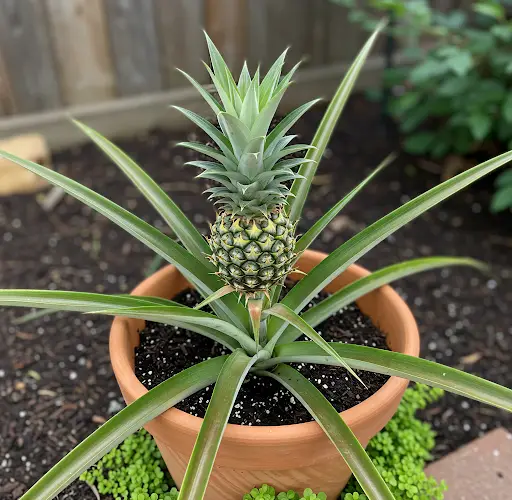How to Grow Pineapples from the Crown and Speed Up Fruit Production
Growing pineapples at home is an enjoyable and rewarding process, and one of the best methods is by cultivating them from the crown. In this guide, I’ll show you how to grow a pineapple from the crown and provide tips on speeding up the fruiting process so you can enjoy a quicker and more abundant harvest.
How to Propagate a Pineapple from the Crown
To begin, you’ll need a ripe pineapple. Start by cutting off the crown (the leafy top) of the pineapple. The crown can be easily removed by twisting it gently. Afterward, you can remove any excess fruit from the base of the crown and prepare it for rooting.
Place the pineapple crown in a jar or glass with some water. You can use a regular cream cheese jar or any small container. Submerge the base of the crown in the water, making sure the water level does not cover the leaves. Change the water every couple of days to prevent mold or fungus growth. After about three days, you’ll begin to notice the formation of small roots at the base of the crown.
It’s important to keep the crown in water for about four to five days. You’ll see the roots grow significantly within this time, at which point the pineapple crown is ready to be planted in soil.
Preparing the Soil and Container for Planting
Before planting, choose a well-draining container. For this process, I recommend using a 20-liter plastic bottle with holes at the bottom for drainage. This ensures the roots don’t stay submerged in excess water, which can lead to root rot.
Fill the container with a mixture of 80% dark soil and 20% sand. The sand helps improve drainage, which is crucial for preventing mold and fungus. Once the container is filled, make a small hole in the center using your fingers.
Now, take your rooted pineapple crown and gently place it into the hole. Make sure the roots are well covered with soil, and press down firmly around the base to ensure the crown is stable. Once the crown is in place, fill the container with more soil until it’s nearly at the top. Gently pat down the soil to secure the crown further.
Watering and Initial Care
Once your pineapple crown is planted, water it generously. Make sure the water drains well, as excessive moisture can lead to mold or rot. For the first few weeks, keep the soil moist but not soaking wet. Pineapples prefer warm, sunny locations, so place the pot in a spot that receives plenty of direct sunlight.
Accelerating Pineapple Fruiting
While it may take a bit of patience, there are a few things you can do to speed up the fruiting process for your pineapple plant.
-
Provide Plenty of Sunlight: Pineapples thrive in warm, sunny environments. Make sure your plant receives at least 6 hours of sunlight a day. If you live in a cooler region, you may need to use a greenhouse or place the plant in a sunny windowsill to ensure it gets enough light.
-
Proper Fertilization: Pineapples do not require any specific fertilizer, but they benefit from organic fertilizers rich in phosphorus, potassium, and nitrogen. These nutrients encourage root growth and support the plant during the flowering and fruiting stages.
-
Consistent Watering: Water your pineapple plant regularly, but avoid overwatering. Pineapples like their soil to be moist but well-drained. Watering once a day is typically sufficient, especially during the warmer months.
-
Soil Quality: The quality of the soil is more important than its chemical composition. Pineapples prefer well-draining soils, so sandy or loamy soils are ideal. The soil should be rich in organic matter but should not retain too much water, which could harm the plant.
The Pineapple Growth Cycle
Pineapples have a unique growth cycle. Initially, the plant will focus on vegetative growth, expanding its leaves and roots. Over time, it will start producing small offshoots or “pups” at the base of the crown. These pups can be used to propagate new pineapple plants once they reach a certain size.
The main pineapple fruit will start developing after about 12-18 months of growth. When the fruit is mature, you can carefully cut it off. After harvesting the fruit, the plant will begin to die off, but it will have already produced several pups that can be used for new plantings.
Tips for a Faster Harvest
To speed up the process of fruit production, ensure your pineapple plant is growing in the best possible conditions. Keep it in a sunny location, water it regularly, and use the right soil mix. You can also help encourage flowering by using natural methods like increasing the plant’s exposure to ethylene gas (which can be done by placing a ripe apple nearby). However, patience is key—pineapples take time to mature, but the reward of homegrown fruit is well worth it.
Conclusion
Growing pineapples from the crown is a simple and effective method to cultivate this tropical fruit at home. With proper care, sunlight, and a little patience, you can enjoy homegrown pineapples in about 12 to 18 months. By following the tips outlined here, you can ensure your pineapple plant grows healthily and produces fruit faster. Whether you’re using a small container or a larger pot, the key to success is proper soil drainage, regular watering, and plenty of sunlight.
By understanding the growth cycle and providing the right conditions, you’ll be able to enjoy the satisfaction of growing your very own pineapple at home.



